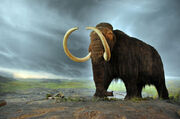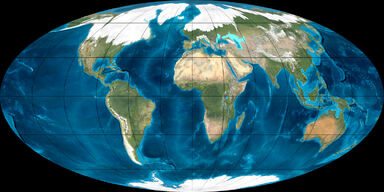| New Pleistocene |
|---|
| This page is a part of New Pleistocene, a collaborative project detailing the fauna of the next glacial period. |

|
This is a community project. That means anyone can edit. However, unwanted changes can and will be edited or removed. This project is owned by Whanggoldpaw and is co-owner of Killerparrot1.
Before New Pleistocene[]
It's the dawn of humanity's science age. Human beings also become more technologically advanced and most factory and manual labor are carried out by synthetic machines or genetically modified organisms. This leaves humans with job opportunities like de-extinction, rewilding and other more human-centered careers, like store owners and soldiers. Gun and birth control become serious preaching of governments. The most successful world powers in order from greatest to least are US, China, Russia, Canada and Great Britain. Though some countries do still play an important part in the world economy. Humans almost completely converge into one race of human.
Doing our best efforts, tigers in India become no longer extinct, though Siberian tigers still persist and a small colony of Chinese tigers introduced to Africa seem to do fairly well. Marine mammals especially majority of species living in warm waters no longer faced grieve dangers of extinction due to shrink of overall distributions and increased competitions with species from north. Some were saved through captive breeding and artificial introductions into designated, landlocked waters. Arctic, Antarctic, and sub-polar species on the other hand thrived relatively well.
Marine mammals especially majority of species living in warm waters faced grieve dangers of extinction due to shrink of overall distributions and increased competitions with species from north. Some were saved through captive breeding and artificial introductions into designated, landlocked waters. Arctic, Antarctic, and sub-polar species on the other hand thrived relatively well.
Our efforts to save the Asian rhinoceros and northern white rhinoceros became ended successfully, but the southern white rhinoceros, Indian rhinoceros and most surprisingly the black rhinoceros manage to survive. Most large African animals had to adapt to the rising human population using new migratory routes to and relying on nature perseveres (also can be said for North and South America).
Though some creatures benefited from human expansion urbanizing to our environment. An odd urbanized animal is the blue penguin, which was considered a pest in African cities (clogging sewer systems) thrived. Though some attempts to get rid of the species was practiced, they managed to keep coming back. Then after nearly centuries without war, a economic shattering catastrophic war breaks loose, which causes over 60% of human beings on Earth to be killed of while the remaining slowly died off like most livestock. The remainder of humans moved to Mars with best efforts to terraform it. Leaving the fauna of the earth to control their own destinies.
Most large African animals had to adapt to the rising human population using new migratory routes to and relying on nature perseveres (also can be said for North and South America). Though some creatures benefited from human expansion urbanizing to our environment. An odd urbanized animal is the blue penguin, which was considered a pest in African cities (clogging sewer systems) thrived. Though some attempts to get rid of the species was practiced, they managed to keep coming back. Then after nearly centuries without war, a economic shattering catastrophic war breaks loose, which causes over 60% of human beings on Earth to be killed of while the remaining slowly died off like most livestock. The remainder of humans moved to Mars with best efforts to terraform it. Leaving the fauna of the earth to control their own destinies.
5 Million Years in the Future[]
It's the dawn of a new Ice Age. Ice sheets extend as far south as Paris in the northern hemisphere and as far north as Buenos Aires in the southern hemisphere. North America's western great plains have become hot and dry. A majority of South America is Grassland, only the Amazon River houses the rainforest of South America. Europe has become increasingly colder making way for a cold savanna environment, while Asia has become dryer and more mountainous. Russia, Australia and Antarctica have relatively stayed the same. Though the fauna changed drastically in Australia and New Zealand, as invasive and introduced species start to change the ecosystem drastically. Prior to this ice age, the polar icecaps decreased rapidly causing small isles and islands to form. These allowed some of the animals to become larger on those islands, due to insular gigantism. When the new ice age started, many of the islands become reconnected to their mainland continent and the animals spread out across the continents. One of these islands became a new continent called Zealandia. This new continent affected the water currents to southern Australia as Zealandia's many peninsulas blocked them, which created a cooler climate down under. Zealandia's is mainly tropical up north as it gets Australia's warm currents creating a environment similar to that of of Madagascar's east coast. Also similar to Madagascar is Zealandia's west coast. which is dry and colder.
Fauna wise, little has changed. Most wild animals that changed either went on a path to becoming larger or a path to becoming smaller. A few feral animal descendants manage to survive as well, horses did relatively well in most places they were introduced. Sheep and goat breeds persisted and diversified in the British Isles. One of the most successful canids on Earth at this time are foxes , having over 40 species at this time. They are followed by the two other most successful canid domestic dog-descendants and the coyote/coywolves Along withe the most successful feline being the descendants of domestic cats. Huge snowy owls, the size of the Cretaceous's Quetzalcoatlus, glide over the ice sheets, feeding on carrion and medium sized mammals. Though the most successful mammals of this future are rodents. Though mammals aren't the only successful animals, like dogs the extreme variation in chickens allowed them to form many new species around the world. Some being herbivorous while others are carnivorous. Pigeons, specifically descendants of the heavily introduced feral rock dove diversified quite a bit.

Continents[]
Subcontinents/Archipelagos/Islands[]
Winners and Losers[]
Winners[]
- Canids - Canids were very successful, especially descendants and subspecies of Canis lupus, Cuon alpinus, Lycaon pictus, Speothos, Vulpes vulpes and Canis Latrans
- Sus - Sus were successful mainly because of introduction and escapes of wild boar and their domestic subspecies. They are present on almost all of the continents.
- Felis - the introduction of domestic cats and their adaptability helped them form many new species and subspecies across the continents.And creating a New genus of cat Known as ProtoSmilodons
- Panthera - all species of Panthera survived, mostly due to protection and population expansion by humans, even most of the tiger subspecies were saved from the brink of extinction due to conservationists and captive breeding programs.
- Columbidae - the introduction of rock doves to many places made many new species. Passenger pigeons were also cloned and became successful and widespread once again.
- Procyon - raccoons survived because of there adaptability and dependence on human beings. After human beings, they took a relatively big hit in worldwide populations, but managed to survive and form three separate species, the American species, the Eurasian species and the Japanese species.
- Spiked Rodents - Spiked tailed round mouse is a great survivor, and has a strong advantage against natural storms and large animals species.
- Pseudoryx - Saolas are good survivors, they saved by humans and expanded their range to worldwide, Asian saola (Pseudoryx ngetinhensis) created new species: European saola (Pseudoryx europaeus), African saola (Pseudoryx tanzaniacus), Amur (Japanese) saola (Pseudoryx nippon) & Icelandic saola (Pseudoryx groenlandicus)
